NCERT Exemplar Solutions for Class 10 Maths Chapter 12 Area Related To Circles
Area Related To Circles Introduction
We are familiar with the shape of a circle. The circumference of the wheels of cars, and coins appears as a circle.
A circle can be defined as “A figure with an outline, every point on this outline is at the same constant distance from a certain point inside the figure, which is called the centre”.

NCERT Exemplar Class 10 Maths Chapter 12
NCERT Exemplar Solutions for Class 10 Maths Chapter 12 Area Related To Circles Area And Circumference Of A Circle
Let r be the radius of the circle. The distance travelled once around a circle is its perimeter, usually called its circumference. Now
Area of circle = πr2
Circumference of circle = 2πr
Read and Learn More Class 10 Maths Solutions Exemplar
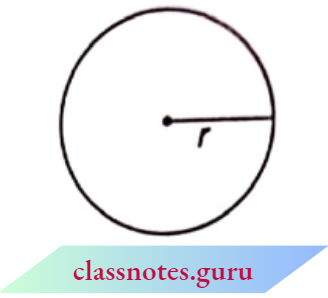
π(pi) is a fixed irrational number whose approximate value is \(3.1416 \text { as } \frac{22}{7} \text { or } \frac{355}{113}\) (sometimes)
Diameter: A chord of a circle passing through its centre is called the diameter of the circle.
Diameter = 2 x radius
NCERT Exemplar Solutions for Class 10 Maths Chapter 12 Area Related To Circles Formulae Of Circle
1. Area of circle = πr2
2. Circumference of a circle = 2πr

3. Area of semicircle = \(\frac{1}{2} \pi r^2\)

4. Perimeter of semicircle = (πr + 2r)
5. For a ring having outer radius = R and inner radius = r
Area of ring = π(R2 – r2)
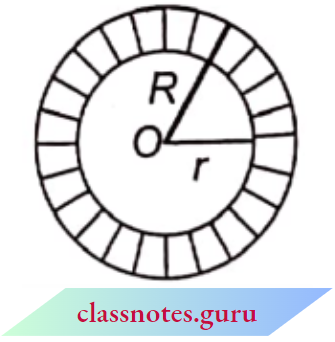
6. For rotation of the hands of a clock
- Angle described by minute hand in 60 minutes = 360°
- Angle described by hour hand in 12 hours = 360°
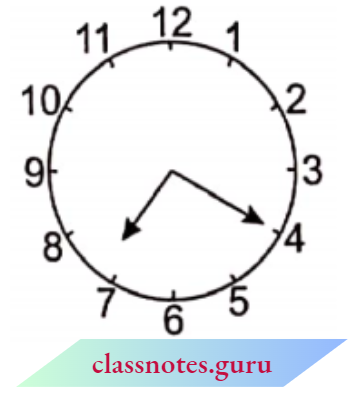
7. For rotating wheels
- Distance moved by a wheel in 1 rotation = its circumference
- Number of rotation in unit time = \(\frac{\text { distance moved in unit time }}{\text { circumference }}\)
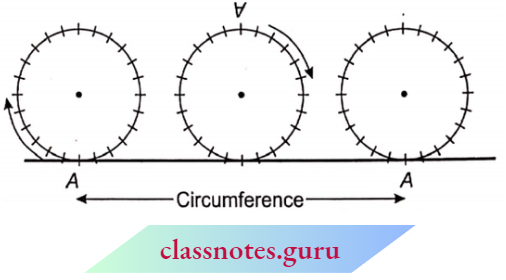
NCERT Exemplar Solutions for Class 10 Maths Chapter 12 Area Related To Circles Solved Examples
Question 1. The circumference of a field is 220 m. Find
- Its radius
- Its area.
Solution:
Circumference of circle = 220 m
2πr = 220
⇒ \(r=\frac{220 \times 7}{2 \times 22}=35 \mathrm{~m}\)
Area of circle = \(\pi r^2=\frac{22}{7} \times 35 \times 35=3850 \mathrm{~m}^2\)
Question 2. Find the area of a circular park whose radius is 4.5 m.
Solution:
Area of circular park = r2
⇒ Area = \(\text { Area }=\frac{22}{7} \times 4.5 \times 4.5\)
Area = 63.63 m2
The area of a circular park = 63.63 m2
Question 3. The area of a circular plot is 346.5 m2. Calculate the cost of fencing the plot at the rate of ₹ 6 per metre.
Solution:
Area of plot = 346.5 m2
⇒ πr2 = 346.5 m2 ⇒ \(r^2=\frac{346.5 \times 7}{22}\)
⇒ r2 = 110.25 ⇒ r = 10.5 m
Circumference of plot = \(2 \pi r=2 \times \frac{22}{7} \times 10.5=66 \mathrm{~m}\)
Cost of fencing = Circumference x Cost of fencing per metre
= ₹ 66 x 6 = ₹ 396
The cost of fencing the plot at the rate of ₹ 6 per metre = ₹ 396
Question 4. The diameter of a cycle wheel is 28 cm. How many revolutions will it make in moving 13.21cm?
Solution:
Given
The diameter of a cycle wheel is 28 cm.
Distance travelled by the wheel in one revolution = \(2 \pi r=\frac{22}{7} \times 28=88 \mathrm{~cm}\)
Total distance travelled by the wheel = 13.2 x 1000 x 100 cm
Number, of revolutions made by the wheel = \(\frac{\text { total distance }}{\text { circumference }}\)
= \(\frac{13.2 \times 1000 \times 100}{88}=15000 \text { revolutions }\)
15000 revolutions will it make in moving 13.21cm.
Question 5. The circumference of a circle exceeds the diameter by 16.8 cm. Find the radius of the circle.
Solution:
Given
The circumference of a circle exceeds the diameter by 16.8 cm.
Let the radius of the circle be r.
Diameter = 2r
Circumference of circle = 2πr
Using the given information, we have
2πr = 2r + 16.8
⇒ \(2 \times \frac{22}{7} \times r=2 r+16.8\)
⇒ 44r = 14r + 16.8 x 7
⇒ 30r = 117.6
∴ \(r=\frac{117.6}{30}=3.92 \mathrm{~cm}\)
The radius of the circle =3.92 cm
Question 6. Find the area of a ring whose outer and inner radii are respectively 20cm and 1 5cm.
Solution:
Outer radius R = 20 cm
Inner radius r = 15 cm
∴ Area of ring = π(R2 – r2)
⇒ Area of ring = \(\frac{22}{7}\left[(20)^2-(15)^2\right]=\frac{22}{7}(400-225)=\frac{22}{7} \times 175 \mathrm{~cm}^2\)
= 22 x 25 = 550 cm2.
The area of a ring = 550 cm2.
Question 7. A race track is in the form of a ring whose inner circumference is 352 m and the outer circumference is 396 m. Find the width of the track.
Solution:
Given
A race track is in the form of a ring whose inner circumference is 352 m and the outer circumference is 396 m.
Let R and r be the outer and inner radii of the circle.
The width of the track = (R – r) cm
Now, 2πr = 352 ⇒ \(2 \times \frac{22}{7} \times r=352\)
⇒ \(r=\frac{352 \times 7}{2 \times 22}=7 \times 8=56 \mathrm{~m}\)
Again, 2πR = 396 ⇒ \(2 \times \frac{22}{7} \times R=396\)
⇒ \(R=\frac{396 \times 7}{2 \times 22}=7 \times 9=63 \mathrm{~m}\)
∴ R = 63 m, r = 56 m
Width of the track = (R- r) m = (63 – 56) m = 7 m.
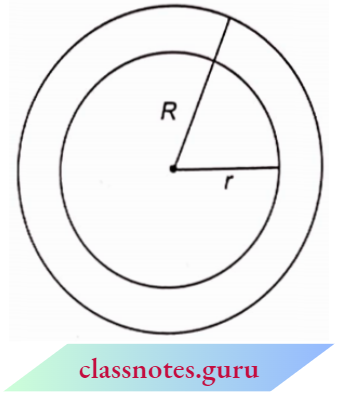
Question 8. Two circles touch internally. The sum of their areas is 116π cm2 and the distance between their centres is 6 cm. Find the radii of the circles.
Solution:
Given
Two circles touch internally. The sum of their areas is 116π cm2 and the distance between their centres is 6 cm.
Let two circles with centres O’ and O having radii R and respectively touch each other at P.
It is given that OO’ = 6
R – r = 6 ⇒ R = 6 + r → (1)
Also, πR2 + πr2 = 116π (given)
π(R2 + r2) = 116π
⇒ R2 + r2= 116 → (2)
∴ From equations (1) and (2), we get
(6 + r)2 + r2 = 116
⇒ 36 + r2 + 12r + r2= 116 ⇒ 2r2 + 12r – 80 = 0
⇒ r2 + 6r – 40 = 0 = (r + 10) (r – 4) = 0
∴ r = -10 or r = 4
But the radius cannot be negative. So, we reject r = -10
∴ r = 4 cm
∴ R = 6 + 4 = 10cm [from(1)]
Hence, the radii of the two circles are 4 cm and 10 cm.

Area Related to Circles Class 10 Exemplar Solutions
Question 9. The radius of a wheel of a bus is 45 cm. Determine its speed in kilometres per hour, when its wheel makes 315 revolutions per minute.
Solution:
Given
The radius of the wheel of the bus = 45 cm
∴ Circumference of the wheel = 2ar
= \(2 \times \frac{22}{7} \times 45=\frac{1980}{7} \mathrm{~cm}\)
∴ Distance covered by the wheel in one revolution = \(\frac{1980}{7} \mathrm{~cm}\)
Distance covered by the wheel in 315 revolutions = \(315 \times \frac{1980}{7}\)
= 45 x 1 980 = 89 100 cm
= \(\frac{89100}{1000 \times 100} \mathrm{~km}=\frac{891}{1000} \mathrm{~km}\)
∴ Distance covered in 60 minutes or 1 hr =\(\frac{891}{1000} \times 60=\frac{5346}{100}=53.46 \mathrm{~km}\)
Hence, speed of bus = 53.46 km/hr
Question 10. Three semicircles each of diameter 3 cm, a circle of diameter 4.5 cm and a semicircle of radius 4.5 cm are drawn in the adjoining figure. Find the area of the shaded region.
Solution:
Given
Three semicircles each of diameter 3 cm, a circle of diameter 4.5 cm and a semicircle of radius 4.5 cm are drawn in the adjoining figure.
Required area = (area of larger semicircle with radius 4.5 cm) – (area of two smaller semicircles with radius of each \(\frac{3}{2}\) cm and a circle with radius \(\frac{4.5}{2}\) cm + (area of smaller semicircle with radius \(\frac{3}{2}\) cm)
= \(\frac{1}{2} \pi(4.5)^2-\left[2 \times \frac{1}{2} \pi\left(\frac{3}{2}\right)^2+\pi\left(\frac{4.5}{2}\right)^2\right]+\left[\frac{1}{2} \pi\left(\frac{3}{2}\right)^2\right]\)
= \(\frac{1}{2} \pi(4.5)^2-\pi\left(\frac{3}{2}\right)^2-\pi\left(\frac{4.5}{2}\right)^2+\frac{1}{2} \pi\left(\frac{3}{2}\right)^2\)
= \(\frac{1}{4} \pi\left[2 \times(4.5)^2-9-(4.5)^2+\frac{9}{2}\right]=\frac{1}{4} \pi \times 4.5[2 \times 4.5-2-4.5+1]\)
= \(\frac{1}{4} \pi \times 4.5(3.5)=\frac{1}{4} \times \frac{22}{7} \times 4.5 \times 3.5=12.375 \mathrm{~cm}^2\).
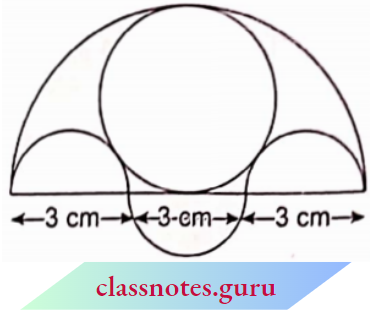
The area of the shaded region =12.375 cm².
Question 11. In the adjoining figure, find the area of the shaded region. (Use π = 3.14)
Solution:
Diameter BD = \(\sqrt{6^2+8^2}=\sqrt{36+64}=\sqrt{100}=10 \mathrm{~cm}\)
Radius = \(]frac {10}{2}\) = 5 cm
Area of circle = πr2 = 3. 1 4 x 52 = 3. 14 x 25 = 78.50 cm2
Area of rectangle ABCD = 8 x 6 = 48 cm2
Hence, area of shaded region = 78.50- 48 = 30.5 cm2
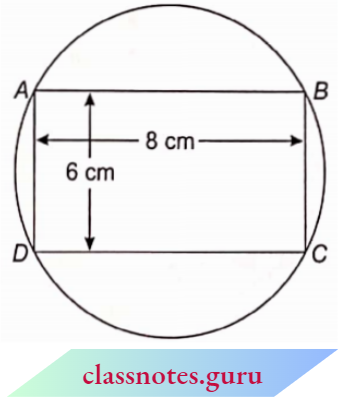
Question 12. A park is of the shape of a circle of diameter 7 m. It is surrounded by a path of width 0.7 m. Find the expenditure of cementing the path, if its cost is ₹ 110 per sq. m.
Solution:
Given
A park is of the shape of a circle of diameter 7 m. It is surrounded by a path of width 0.7 m
The radius of the circular park = 3.5 m
There is a path of width 0.7 m.
So, the radius of the external circle R = 3.5 + 0.7
⇒ R = 4.2 cm
Area of path = πR2 – πr2 = n(R- r) (R + r)
= \(\frac{22}{7}(4.2-3.5)(4.2+3.5)\)
= \(\frac{22}{7} \times 0.7 \times 7.7=16.94 \mathrm{~m}^2\)
Now, the cost of cementing 1 m2 of path = ₹ 110
Cost of cementing 16.94 m2 of path = ₹ ( 110 x 16.94) = ₹ 1863.40

Question 13. Find the area of the region between the two concentric circles, if the length of a chord of the outer circle just touching the inner circle at a particular point on it is 10 cm. \(Take, \pi=\frac{22}{7}\)
Solution:
Let the chord AB touch the inner circle at C and let 0 be the centre of both the circles, then
OC = r, OA = R and AB = 10 cm
Now, since OC ⊥ AB (∵ radius through the point of contact is perpendicular to the tangent)
∴ C is the mid-point of AB (∵ ⊥ drawn from the centre to the chord, bisects the chord)
⇒ \(A C=\frac{1}{2} A B=\frac{1}{2} \times 10=5 \mathrm{~cm}\)
Now, in right ΔOCA,
OA2 = OC2 +AC2 (by Pythagoras theorem)
R2 – r2 = 25 → (1)
The required area of the region between two concentric circles
= πR2 – πr2 = π(R2– r2) – 25π [from(1)]
= \(25 \times \frac{22}{7}=78.57 \mathrm{~cm}^2\)

Question 14. In the adjoining figure, CM = 5 cm, RB = 9 cm, CD ⊥ AB, O is the centre of the larger circle and K is the centre of the smaller circle. Find the area of the shaded region.
Solution:
Let the radius of the larger circle be R and the radius of the smaller circle is r.
Since, CM = 5 cm
∴ MO = R – 5
Also OB = R and RB = 9
∴ OR = R – 9
In ΔAOM,
∠1 + ∠2 = 90° → (1)
In ΔAMR,
∠2 + ∠3 = 90° (the angle in a semicircle is the right angle) → (2)
From eqs. (1) and (2), we get
∠1 + ∠2 = ∠2 + ∠3
⇒ ∠1 = ∠3
In Δs AMO and MOR
∠1 = ∠3 (just proved)
∠4 = ∠5 (each 90°)
∴ ΔAMO ~ ΔMRO (AA corollary)
∴ \(\frac{M O}{R O}=\frac{A O}{M O}\)
⇒ \(\frac{R-5}{R-9}=\frac{R}{R-5}\)
⇒ (R – 5)2 = R (R-9) = R2 + 25 – 10R = R2 – 9R
⇒ R = 25 cm
Now, 2R – 9 = 2r ⇒ 2r = 41
⇒ r = 20.5 cm
Required area = πR2 – πr2 = π(R + r) (R – r)
= \(\frac{22}{7} \times 45.5 \times 4.5 = 643.5 \mathrm{~cm}^2\)

Question 15. A square of the largest area is cut out of a circle. What % of the area of the circle is lost as trimmings?
Solution:
Let the radius of the circle be r units.
∴ Area of circle = πr2 sq. units
Let ABCD be the largest square.
∴ Length of diagonal = 2r = side √2
side = \(\frac{2 r}{\sqrt{2}}=\sqrt{2} r\)
∴ Area (square ABCD) = (side)2 = (√2r)2 = 2r2
∴ Area of circle lost by cutting out of a square of largest area = 2r2
∴ Required percentage of the area of circle lost = \(\frac{2 r^2}{\pi r^2} \times 100=\frac{200}{\pi} \%\).

Question 16. In a circular table covering of radius 32 cm, a design (shade) is formed leaving an equilateral triangle ABC in the middle as shown in the adjacent figure. Find the area of the shaded region.
Solution:
Since ABC is an equilateral triangle.
∴ ∠A = 60°
⇒ ∠BOC = 2 x ∠BAC = 2 x 60° = 120° (degree measure of an arc is twice the angle subtended by it in an alternate segment)
Draw OM ⊥ BC
So, we can prove
ΔOMB ≅ ΔOMC (R.H.S. congruency)
∴ ∠BOM = ∠COM = 60° (c.p.c.t.)
In the right ΔOMB, we have
⇒ \(\sin 60^{\circ}=\frac{B M}{O B}\)
∴ \(\frac{\sqrt{3}}{2}=\frac{B M}{32} \quad = \quad B M=16 \sqrt{3} \mathrm{~cm}\)
∴ BC = 2 x 16√3 = 32√3 cm
∴ Area of shaded region = Area of circle- ar(AABC)
= \(\pi r^2-\frac{(\text { side })^2 \sqrt{3}}{4}=\pi \times(32)^2-(32 \sqrt{3})^2 \times \frac{\sqrt{3}}{4}\)
= \((32)^2\left(\frac{22}{7}-\frac{3 \sqrt{3}}{4}\right)=1024\left(\frac{22}{7}-\frac{3 \sqrt{3}}{4}\right) \mathrm{cm}^2\)
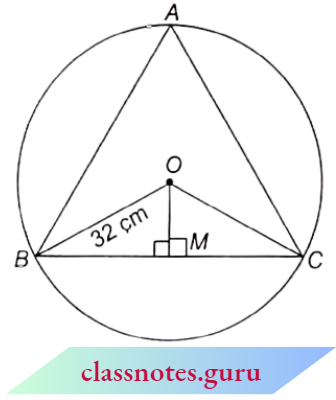
NCERT Exemplar Solutions for Class 10 Maths Chapter 12 Area Of Sector And Segment Of A Circle
Sector: The shaded region (shown in the figure) OAXB is called a sector of the circle. Its boundary consists of arc AXB and two radii OA and OB. This sector has an angle θ, subtended at the centre of the circle by the arc AXB.
The region bounded by two radii of a circle and intercepted by them is called a sector of the circle.

When θ < 180°, arc AB is a minor arc and when θ > 180°, arc AB is a major arc.
Now for sector AOB with ∠AOB = θ°, then the length of minor arc AB \(2 \pi r \times \frac{\theta}{360^{\circ}} \text { i.e., } \frac{\pi r \theta}{180^{\circ}}\)
(Actually, 2πr is the distance covered in travelling the whole circumference in which an angle of 360 is formed at the centre. But for the length of the arc AXB, we do not rotate 360°, here we needed only 0 part of 360°)
∴ \(l=\frac{2 \pi r \theta}{360}\)
and the area of sector is \(\pi r^2 \times \frac{\theta}{360^{\circ}}\)
∴ \(A=\frac{\pi r^2 \theta}{360^{\circ}}\)
Relation between Length of Arc and Area of Sector
Area of sector \(A=\pi r^2 \times \frac{\theta}{360^{\circ}}\)
= \(\pi r \times \frac{\theta}{360^{\circ}} \times r=\frac{1}{2} \times 2 \pi r \times \frac{\theta}{360} \times r=\frac{1}{2} l r\)
Segment of a Circle: A segment of a circle is defined as the part of a circle bounded by a chord and the circumference. The segment containing the major arc is the major segment while the segment containing the minor arc is a minor segment.
Area of minor segment = Area of the sector- an area of ΔOAB.
= \(\left(\frac{\pi r^2 \theta}{360^{\circ}}-\frac{1}{2} r^2 \sin \theta\right) \text { sq. unit }\)
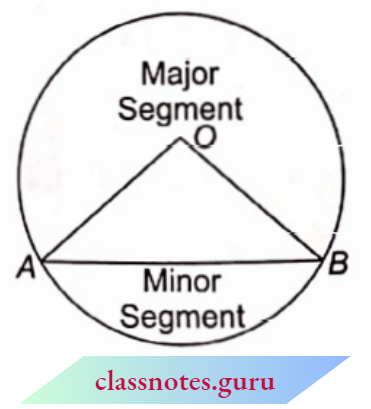
Area of major segment = Area of circle- Area of minor segment
Perimeter of sector = \(\frac{\pi r \theta}{180^{\circ}}+2 r\)
Perimeter of minor segment = \(\frac{\pi r \theta}{180^{\circ}}\) + Length of chord AB
Area of semicircle = \(\frac{\pi r^2}{2}\)
Perimeter of semicircle = \(\pi r+2 r\)
Area of quarter circle = \(\frac{\pi r^2}{4}\)
Perimeter of quarter circle = \(\frac{\pi r}{2}+2 r\)
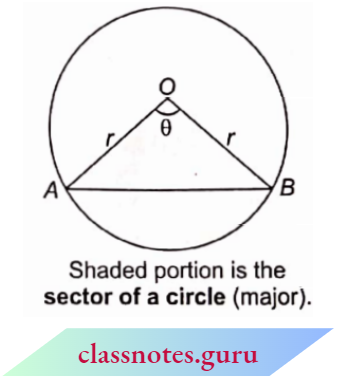
NCERT Exemplar Solutions for Chapter 12 Class 10
NCERT Exemplar Solutions for Class 10 Maths Chapter 12 Area Related To Circles Solved Questions And Answers
Question 1. The perimeter of a semi-circular protractor is 32.4 cm. Calculate:
- The radius of the protractor in cm,
- the arc of the protractor in cm2.
Solution:
Let the radius of the protractor be r cm.
Perimeter of semicircle protractor = (πr + 2r)cm
∴ r(π + 2) = 32.4
⇒ \(r\left(\frac{22}{7}+2\right)=32.4\)
⇒ \(r \times \frac{36}{7}=32.4 \quad ⇒ \quad r=\frac{32.4 \times 7}{36} ⇒ r=6.3 \mathrm{~cm}\)
Hence, the radius of the protractor = 6.3 cm
Area of semi-circular protractor = \(\frac{1}{2} \pi r^2\)
= \(\frac{1}{2} \times \frac{22}{7} \times 6.3 \times 6.3=62.37 \mathrm{~cm}^2\)
Hence, the area of the protractor = 62.37 cm2
Question 2. The minute hand of a clock is √2I cm long. Find the area described by the minute hand on the face of the clock between 6 a.m. and 6.05 a.m.
Solution:
In 60 minutes, the minute hand of a clock move through an angle of 360°.
∴ In 5 minutes hand will move through an angle = \(\frac{360^{\circ}}{60} \times 5=30^{\circ}\)
Now, r = √21 cm and θ = 30°
The area of sector described by the minute hand between 6 a.m. and 6.05 a.m.
= \(\frac{\pi r^2 \theta}{360^{\circ}}=\frac{22}{7} \times(\sqrt{21})^2 \times 30^{\circ} \times \frac{1}{360^{\circ}}=5.5 \mathrm{~cm}^2\)
Question 3. In the adjoining figure, calculate:
- The length of minor arc ACB
- Area of the shaded sector.
Solution:
Here, θ = 150°, r = 14 cm
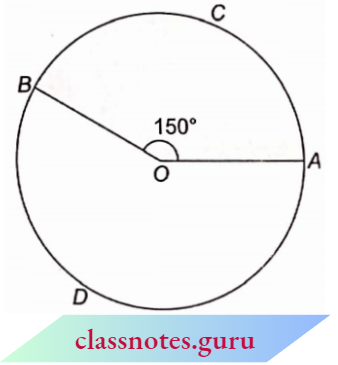
1. Length of minor arc = \(\frac{\pi r \theta}{180^{\circ}}\)
= \(\frac{22}{7} \times 14 \times 150^{\circ} \times \frac{1}{360^{\circ}}\)
= 36.67 cm
2. Area of shaded sector = \(\frac{\pi r^2 \theta}{360^{\circ}}=\frac{22}{7} \times(14)^2 \times 150^{\circ} \times \frac{1}{360^{\circ}}=256.67 \mathrm{~cm}^2\)
Question 4. A chord AB of a circle of radius 10 cm makes a right angle at the centre of the circle. Find the area of the major and minor segments. (Use π = 3.14).
Solution:
Area of sector OAB = \(\frac{\pi r^2 \theta}{360^{\circ}}=3.14 \times 10^2 \times \frac{90^{\circ}}{360^{\circ}}=78.5 \mathrm{~cm}^2\)
Now, area of \(\triangle A O B=\frac{1}{2} \times(10)^2=50 \mathrm{~cm}^2\)
Area of the minor segment = (78.5 – 50) cm2 = 28.5 cm2
Area of the major segment = Area of the circle – Area of the minor segment
= (3.14 x 102 – 28.5) cm2 = (314 – 28.5) cm2 = 285.5 cm2
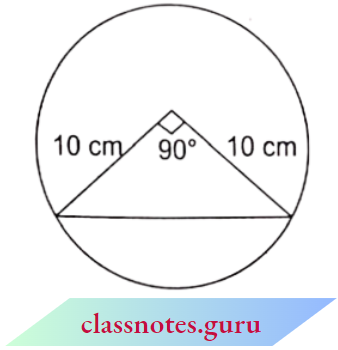
Question 5. In the adjoining figure, the side of the square is 28 cm and the radius of each circle is half of the length of the side of the square where O and O’ are the centres of the circle. Find the area of the shaded region.
Answer:
Side of square = 28 cm
and the radius of each circle = 14 cm
Required area = area of square excluding the two sectors + area of two circles
= \((28)^2-2\left[\pi(14)^2 \times \frac{90^{\circ}}{360^{\circ}}\right]+2\left[\pi(14)^2\right]\)
= \((28)^2-2 \times \frac{22}{7} \times 14 \times 14 \times \frac{1}{4}+2 \times \frac{22}{7} \times 14 \times 14\)
= 784 – 308 + 1232 = 1708 cm2

Question 6. In the adjoining figure, ABCD is a trapezium with AB || DC, AB = 18 cm, DC = 32 cm and the distance between AB and DC is 14 cm. If arcs of equal radii 7 cm taking A, B, C and D as centres, have been drawn, then find the area of the shaded region.
Solution:
Area of the shaded region
= area of trapezium – area of four sectors
= \(\begin{aligned}
\frac{1}{2} \times 14(32+18)-\left[\pi(7)^2 \times \frac{\angle A}{360^{\circ}}+\right. & \pi(7)^2 \times \frac{\angle B}{360^{\circ}} \left.+\pi(7)^2 \times \frac{\angle C}{360^{\circ}}+\pi(7)^2 \times \frac{\angle D}{360^{\circ}}\right]
\end{aligned}\)
= \(=7 \times 50-\frac{\pi \times(7)^2}{360^{\circ}}(\angle A+\angle B+\angle C+\angle D)\)
= \(=350-\frac{22}{7} \times \frac{7 \times 7}{360^{\circ}} \times 360^{\circ}\) (∵ sum of all the four angles of a quad. is 360°)
= 350 – 154 = 196 cm2
Hence, the area of the shaded region is 196 cm2.
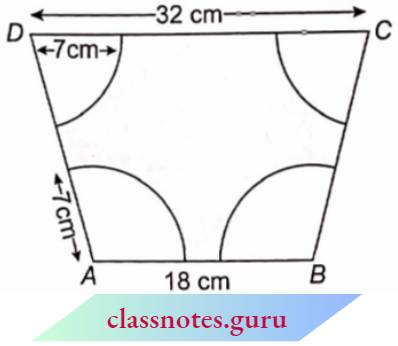
Question 7. In the adjoining figure, two circular flower beds have been shown on two sides of a square lawn ABCD of side 56 m. If the centre of each circular flower bed is the point of intersection O of the diagonals of the square lawn, find the sum of areas of the lawn and the flower beds.
Solution:
We know that the diagonals of a square bisect each other perpendicularly.
∴ ∠DOC = 90°
Also diagonal BD = side √2 = 56√2m
∴ \(O D=\frac{1}{2} \times B D=28 \sqrt{2} \mathrm{~m}\)
∴ Area of \(\triangle D O C=\frac{1}{2} \times 28 \sqrt{2} \times 28 \sqrt{2}=(28)^2 m^2\)
Area of sector ODCO = \(\pi(O D)^2 \times \frac{\theta}{360^{\circ}}\)
= \(\pi(28 \sqrt{2})^2 \times \frac{90^{\circ}}{360^{\circ}}=\frac{11 \times 28 \times 28}{7} \mathrm{~m}^2\)
= 1232 m2
∴ Area of 1 flower bed = Area of sector- Area of A
= 1232 -(28)2 = 448 m2
∴ Area of 2 flowers beds = 2 x 448 = 896 m2
Area of square lawn = (56)2 = 3136 m2
∴ Required area = 896 + 3136 = 4032 m2
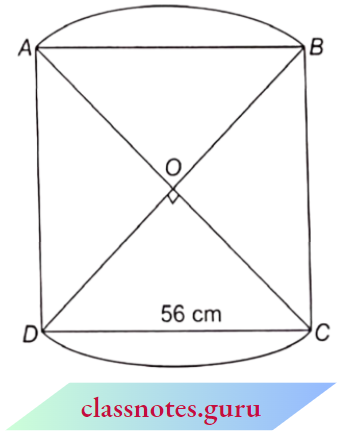
Question 8. In the adjoining, ABCD is a square of side 10 cm and two A semicircles with side of the square as diameter. A quarter circle is also seen with a side of the square as a radius. Find the area of the square region excluding the shaded part (Deepak).(Takeπ = 3.14)
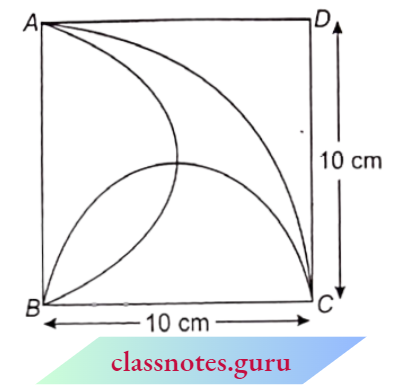
Solution:
First of all, we will find the area of 1 and 2 i.e., Batti of Deepak, draw OM ⊥ AB and ON ⊥ BC.
ar(1) = ar(sector NBKO) – ar(ABNO)
= \(\pi(5)^2 \times \frac{90^{\circ}}{360^{\circ}}-\frac{1}{2} \times 5 \times 5\)
ar (2) = ar (1)
⇒ \(\operatorname{ar}(\mathrm{1}+\mathrm{2})=2\left(\frac{25 \pi}{4}-\frac{25}{2}\right)=\frac{25}{2}(\pi-2)\)
∴ \(\frac{25}{2}(3.14-2)=14.25 \mathrm{~cm}^2\)
Now, area of deepak = ar(quadrant APCB) – [ar(semicircle 4 + 1 + 2) + ar(semicircle 5 + 1 + 2) – 2 x ar (1 + 2)]
= \(\pi(10)^2 \times \frac{90}{360}-\left[2 \times \frac{\pi(5)^2}{2}-2 \times 14.25\right]\)
25π – (25π – 28.5) = 28.5 cm2
Area of unshaded portion = Area of the square- Area of deepak
= (10)2– 28.5 = 100 – 28.5 = 71.5 cm2
The area of the square region excluding the shaded part = 71.5 cm2
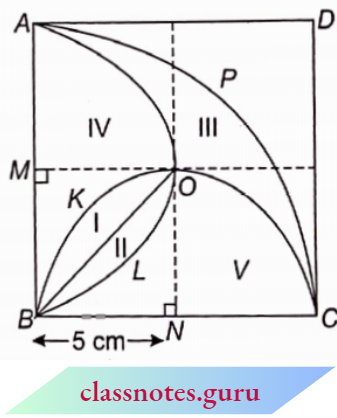
Question 9. If the hypotenuse of an isosceles right triangle is 7√2 cm, find the area of the circle inscribed in it.
Solution:
Let AB = BC = x cm
∴ In right ΔABC, by Pythagoras theorem
x2 + y2 = (7√2)2
⇒ 2x2 = 98 = x2 = 49 ⇒ x = 7 cm
∴ ar(ABC) = ar(AOB)+ ar(BOC) + ar(COA)
⇒ \(\frac{1}{2} \times x \times x=\frac{1}{2} \times x \times r+\frac{1}{2} \times x \times r+\frac{1}{2} \times 7 \sqrt{2} \times r\)
⇒\(r=\frac{7}{2+\sqrt{2}} \times \frac{2-\sqrt{2}}{2-\sqrt{2}}=\frac{7(2-\sqrt{2})}{2}\)
⇒ \(7 \times 7=7 \times r+7 \times r+7 \sqrt{2} \times r \Rightarrow r=\frac{7}{2+\sqrt{2}}\)
Area of circle = πr2
= \(\frac{22}{7} \times \frac{49(2-\sqrt{2})^2}{4}=\frac{77}{2} \times(4+2-4 \sqrt{2})\)
= 77(3 – 2√2) cm2
The area of the circle inscribed in it = 77(3 – 2√2) cm2
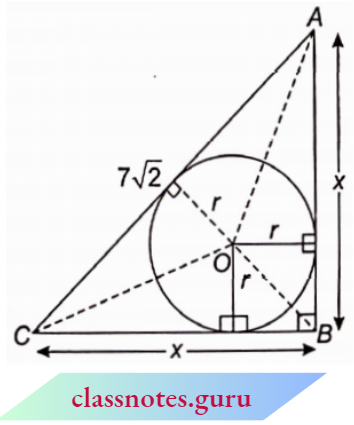
Question 10. In the adjoining figure, two concentric circles with centre O have radii of 21 cm and 42 cm. If ∠AOB = 60°, find the area of the shaded region. (\(\text { Use } \pi=\frac{22}{7}\))
Solution:
Required area = area of a larger circle with a radius of 42 cm – an area of a smaller circle with a radius of 21 cm – (area of unshaded portion CDBA)
= π(42)2 – π(21 )2 – [(area of the larger sector with radius 42 cm) – (area of the smaller sector with radius 21 cm)]
= \(\pi(42)^2-\pi(21)^2-\left[\pi(42)^2 \times \frac{60}{360}-\pi(21)^2 \times \frac{60}{360}\right]\)
= \(\pi(42)^2-\pi(21)^2-\frac{1}{6} \pi(42)^2+\frac{1}{6} \pi(21)^2=\frac{5}{6} \pi(42)^2-\frac{5}{6} \pi(21)^2\)
= \(\frac{5}{6} \pi \times(21)^2[4-1]=\frac{5}{6} \times \frac{22}{7} \times 21 \times 21 \times 3=3465 \mathrm{~cm}^2\)
The area of the shaded region =3465 cm²

Question 11. In the adjoining figure, O is the centre of the circle with AC = 24 cm, AB = 7 cm and ∠BOD = 90°. Find the area of the shaded region.
Solution:
Since O is the centre of the circle.
∴ BC is the diameter of the circle.
∴ ∠CAB = 90° (angle in a semicircle is a right angle)
Now in right ΔACB, by Pythagoras Theorem,
BC2 = AC2 + AB2 = (24)2 + (7)2 = 576 + 49 = 625
∴ BC = = 25 m
∴ Diameter of circle = 25 m
∴ Radius of circle = \(\frac{25}{2}\) = 12.5 m
∴ OC = OD = 12.5 m (each radii)
∴ Area of shaded region = area of circle – ar (ΔABC) – ar (sector COD)
= \(\pi(12.5)^2-\frac{1}{2} \times A C \times A B-\pi(O C)^2 \times \frac{90^{\circ}}{360^{\circ}}\)
= \(\frac{22}{7} \times 12.5 \times 12.5-\frac{1}{2} \times 24 \times 7-\frac{22}{7} \times 12.5 \times 12.5 \times \frac{1}{4}\)
= 491.07 – 84 – 122.768 = 284.302 = 284.30 m2 (approx.)
The area of the shaded region = 284.30 m2 (approx.)
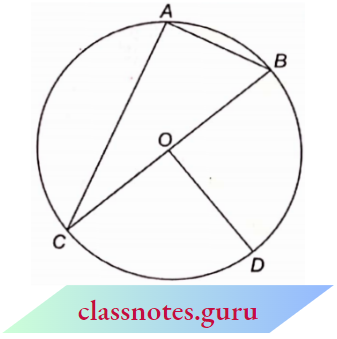
Class 10 Maths Chapter 12 Area Related to Circles
NCERT Exemplar Solutions for Class 10 Maths Chapter 12 Area Related To Circles Exercise 12.1
Question 1. The radii of the two circles are 19 cm and 9 cm respectively. Find the radius of the circle which has a circumference equal to the sum of the circumferences of the two circles.
Solution:
Here, r1 = 19 cm and r2 = 9cm
Let the radius of the new circle = R cm
Given that,
Circumference of new circle = sum of the circumference of given two circles
2πR = 2πr1 + 2πr2
R = r1 + r2 = 19 + 9 = 28 cm.
The radius of the circle = 28 cm.
Question 2. The radii of the two circles are 8 cm and 6 cm respectively. Find the radius of the circle having an area equal to the sum of the areas of the two circles.
Solution:
Here, r1 = 8 cm and r2 = 6 cm
Let the radius of the new circle = R cm
Given that,
Area of new circle = sum of areas of given circles
⇒ πR2 = πr2 + πr2
⇒ R2 = r21 + r22 = 82 + 62
= 64 + 36 = 100
⇒ R = 10 cm
The radius of the circle = 10 cm
Question 3. The depicts an archery target marked with its five scoring regions from the centre outwards as Gold, Red, Blue, Black and White. The diameter of the region representing the Gold score is 21cm and each of the other bands is 10.5 cm wide. Find the area of each of the five scoring regions.
Solution:
The diameter of the Gold circle = 21 cm
∴ Radius of Gold circle = 10.5 cm
Now, the area of the Gold Circle
= \(\frac{22}{7} \times 10.5 \times 10.5 \mathrm{~cm}^2\)
= 346.5 cm2
Given, the width of each band = 10.5 cm
∴ Radius of Red circle = (10.5 + 10.5) = 21cm
Now, area of Red ring = [(external radius)2 – (internal radius)2]
= \(\frac{22}{7}\left[(21)^2-(10.5)^2\right]\)
= \(\frac{22}{7} \times(441-110.25)\)
= \(\frac{22}{7} \times 330.75\)
= 1039.5 cm2
Again, radius of Blue circle = (21 + 10.5)cm = 31.5 cm
∴ Area of Blue ring
= \(\frac{22}{7}\left(31.5^2-21^2\right)\)
= \(\frac{22}{7} \times(992.25-441)\)
= \(\frac{22}{7} \times 551.25\)
= 1732.5 cm2
Again, the radius of the Black Circle
= (31.5 + 10.5)cm
= 42cm
∴ Area of Black circle
= \(\frac{22}{7} \times\left(42^2-31.5^2\right)\)
= \(\frac{22}{7} \times(1764-992.25)\)
= \(\frac{22}{7} \times 771.75=2425.5 \mathrm{~cm}^2\)
Again, radius of white circle = (42 + 10.5) cm
∴ Area of White circle
= \(=\frac{22}{7} \times\left(52.5^2-42^2\right)\)
= \(\frac{22}{7} \times(2756.25-1764)\)
= \(\frac{22}{7} \times 992.25=3118.5 \mathrm{~cm}^2\)
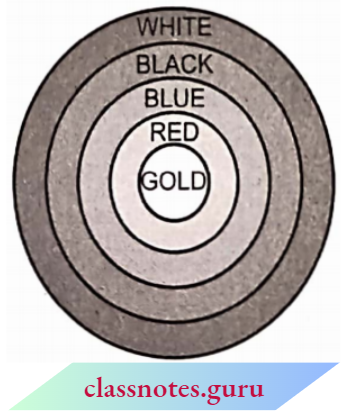
Question 4. The wheels of a car are of diameter 80 cm each. How many complete revolutions does each wheel make in 10 minutes when the car is travelling at a speed of 66 km per hour?
Solution:
The diameter of the wheel of a car, 2r= 80 cm
⇒ r = 40 cm
∴ Distance covered in one revolution
= circumference
= \(2 \pi r=2 \times \frac{22}{7} \times 40=\frac{1760}{7} \mathrm{~cm}\)
Now, speed of car = 66 km/hr
= \(\frac{66 \times 1000 \times 100}{60} \mathrm{~cm} / \mathrm{min}\)
∴ Distance covered in 10 minutes
= \(\frac{66 \times 1000 \times 100}{60} \times 10 \mathrm{~cm}\)
= 11 x 1000 x 100 cm
Now, the number of revolutions made by the wheel
= \(\frac{\text { Total distance covered }}{\text { Distance covered by wheel in 1 revolution }}\)
= \(\frac{11 \times 1000 \times 100}{1760 / 7}\)
= \(=\frac{11 \times 1000 \times 100 \times 7}{1760}=4375 \text { Ans }\)
Question 5. Tick the correct answer in the following and justify your choice: if the perimeter and the area of a circle are numerically equal, then the radius of the circle is:
- 2 units
- units
- 4 units
- 7 units
Solution:
1. 2 units
Let r be the radius of the circle.
Given that, in numerical form, area of circle = perimeter of circle
⇒ πr2 = 2πr ⇒ r = 2 units
NCERT Exemplar Class 10 Maths Area Related to Circles with solutions
NCERT Exemplar Solutions for Class 10 Maths Chapter 12 Area Related To Circles Exercise 12.2
Question 1. Find the area of a sector of a circle with a radius of 6 cm if the angle of the sector is 60°.
Solution:
Here, the radius of the circle, r = 6 cm
The angle of the sector, θ= 60°
∴ Area of sector = \(\frac{\theta}{360^{\circ}} \times \pi r^2\)
= \(\frac{60^{\circ}}{360^{\circ}} \times \frac{22}{7} \times 6 \times 6 \mathrm{~cm}^2\)
= \(\frac{132}{7} \mathrm{~cm}^2 \text { or } 18.86 \mathrm{~cm}^2\)
The area of a sector of a circle is 18.86 cm²
Question 2. Find the area of a quadrant of a circle whose circumference is 22 cm.
Solution:
Circumference of the circle, 2πr = 22
⇒ \(2 \times \frac{22}{7} \times r=22 \quad \Rightarrow \quad r=\frac{7}{2} \mathrm{~cm}\)
Now, the area of the quadrant of a circle
⇒ \(\frac{1}{4} \pi r^2=\frac{1}{4} \times \frac{22}{7} \times \frac{7}{2} \times \frac{7}{2}\)
∴ \(\frac{77}{8} \mathrm{~cm}^2\)
The area of a quadrant of a circle = \(\frac{77}{8} \mathrm{~cm}^2\)
Question 3. The length of the minute hand of a clock is 14 cm. Find the area swept by the minute hand in 5 minutes.
Solution:
Length of minute hand of clock = 14 cm
∴ The radius of the circle, r = 14 cm
∵ The angle subtended by minute hand in 60 min = 360°
∴ Angle subtended by minute hand in 1 minute = \(\frac{360^{\circ}}{60^{\circ}}=6^{\circ}\)
∴ The angle subtended by minute hand in 5 minutes = 30°
∴ From the formula,
area of sector of circle = \(\frac{\theta \pi r^2}{360^{\circ}}\)
= \(30^{\circ} \times \frac{22 \times(14)^2}{7 \times 360^{\circ}}\)
= \(\frac{22 \times 14 \times 2}{12}\)
= \(\frac{616}{12}=\frac{154}{3} \mathrm{~cm}^2\)
The area swept by the minute hand in 5 minutes =\(\frac{154}{3} \mathrm{~cm}^2\)
Question 4. A chord of a circle of radius 10 cm subtends a right angle at the centre. Find the area of the corresponding:
- Minor segment
- Major sector
Solution:
Given, the radius of the circle, AO = 10 cm.
The perpendicular is drawn from the centre of the circle to the chord of the circle which bisects this chord.

AD = DC
And ∠AOD = ∠COD
= 45°
∴ ∠AOC = ∠AOD + ∠COD
= 45° + 45° = 90°
In the right ΔAOD,
⇒ \(\sin 45^{\circ}=\frac{A D}{A O} \quad \Rightarrow \quad \frac{1}{\sqrt{2}}=\frac{A D}{10}\)
AD = 5√2 cm
and \(\cos 45^{\circ}=\frac{O D}{A O} \Rightarrow \frac{1}{\sqrt{2}}=\frac{O D}{10}\)
⇒ OD = 5√2 cm
Now, AC = 2AD
2 x 5√2 = 10√2 cm
Now, the area of ΔAOC
= \(\frac{1}{2} A C \times O D\)
= \(\frac{1}{2} \times 10 \sqrt{2} \times 5 \sqrt{2}=50 \mathrm{~cm}^2\)
Now the area of the sector
= \(\frac{\theta \pi r^2}{360^{\circ}}=\frac{90^{\circ}}{360^{\circ}} \times 3.14 \times(10)^2\)
= \(\frac{314}{4}=78.5 \mathrm{~cm}^2\)
1. Area of minor segment AEC
= area of sector OAEC – area of AOC
= 78.5 – 50 = 28.5 cm2
2. Area of major sector OAFGCO
= area of circle- area of sector OAEC
= πr2– 78.5 = 3.14 x (10)2 – 78.5
314 – 78.5 = 235.5cm2
Question 5. In a circle of radius 21 cm, an arc subtends an angle of 60° at the centre. Find:
- The length of the arc
- The area of the sector formed by the arc
- The area of the segment is formed by the corresponding chord.
Solution:
Here, the radius of circle r = 21 cm
The angle subtended by are at the centre, θ = 60°
1. Length of arc
= \(l=\frac{\theta}{360^{\circ}} \times 2 \pi r\)
= \(\frac{60^{\circ}}{360^{\circ}} \times 2 \times \frac{22}{7} \times 21=22 \mathrm{~cm}\)
2. Area of sector formed by the arc
= \(\frac{\theta}{360^{\circ}} \times \pi r^2\)
= \(\frac{60^{\circ}}{360^{\circ}} \times \frac{22}{7} \times 21 \times 21\)
= 231 cm2
3. Area of segment formed by the corresponding chord
= \(\frac{\pi r^2 \theta}{360^{\circ}}-\frac{1}{2} r^2 \sin \theta\)
= \(231-\frac{1}{2} \times 21 \times 21 \times \sin 60^{\circ}\)
= \(\left(231-\frac{441 \sqrt{3}}{4}\right) \mathrm{cm}^2\)
Question 6. A chord of a circle of radius 15 cm subtends an angle of 60° at the centre. Find the areas of the corresponding minor and major segments of the circle.
(Use π = 3.14 and √3 = 1.73)
Solution:
Given
A chord of a circle of radius 15 cm subtends an angle of 60° at the centre.
Here, the radius of the circle, r = 15 cm
The angle subtended by a chord at the centre, θ = 60°
∴ Area of the corresponding minor segment
= \(\frac{\pi r^2 \theta}{360^{\circ}}-\frac{1}{2} r^2 \sin \theta\)
= \(r^2\left(\frac{\pi \theta}{360^{\circ}}-\frac{1}{2} \sin \theta\right)\)
= \(15 \times 15\left(\frac{3.14 \times 60^{\circ}}{360^{\circ}}-\frac{1}{2} \sin 60^{\circ}\right)\)
= \(225\left(\frac{3.14}{6}-\frac{1}{2} \times \frac{\sqrt{3}}{2}\right)\)
= \(225\left(\frac{3.14}{6}-\frac{1.73}{4}\right)=20.4375 \mathrm{~cm}^2\)
Now, the area of the circle = πr2
= 3.14 x 15 x 15 = 706.5 cm2
∴ Area of major segment = area of circle – an area of the minor segment
= (706.5 – 20.4375) cm2
= 686.0625 cm2.
The areas of the corresponding minor and major segments of the circle = 686.0625 cm2.
Question 7. A chord of a circle of radius 12 cm subtends an angle of 120° at the centre. Find the area of the corresponding segment of the circle.
(Use π = 3.14 and √3 = 1.73)
Solution:
Given
A chord of a circle of radius 12 cm subtends an angle of 120° at the centre.
Here, the radius of the circle, r = 12 cm
The angle subtended by the chord at the centre, θ = 120°
Area of the corresponding minor segment
= \(\frac{\pi r^2 \theta}{360^{\circ}}-\frac{1}{2} r^2 \sin \theta\)
= \(r^2\left(\frac{\pi \theta}{360^{\circ}}-\frac{1}{2} \sin \theta\right)\)
= \(12 \times 12 \times\left(\frac{3.14 \times 120^{\circ}}{360^{\circ}}-\frac{1}{2} \times \sin 120^{\circ}\right)\)
= \(144\left(\frac{3.14}{3}-\frac{1}{2} \times \frac{\sqrt{3}}{2}\right)\)
= \(144\left(\frac{3.14}{3}-\frac{1.73}{4}\right)\)
= 88. 44 cm2
The area of the corresponding segment of the circle = 88. 44 cm2
Question 8. A horse is tied to a peg at one corner of a square-shaped grass field of side 15 m by means of a 5 m long rope. Find:
- The area of that part of the field in which the horse can graze.
- The increase in the grazing area, if the rope were 10 m long instead of 5m. (Use π = 3.14)

Solution:
Given
A horse is tied to a peg at one corner of a square-shaped grass field of side 15 m by means of a 5 m long rope.
Side of square field = 15 m
The radius of the circle, r = 5m
The angle formed by chord, θ = 90°
1. Area of that part of the field where the horse can graze the grass
= \(\frac{\theta}{360^{\circ}} \times \pi r^2=\frac{90^{\circ}}{360^{\circ}} \times 3.14 \times 5^2\)
= 19.625 m2
Area of that part of the field where the horse can graze the grass = 19.625 m2
2. If the length of the rope is 10 m then the increase in the area of grazing.
= \(\frac{90^{\circ}}{360^{\circ}} \times 3.14 \times\left(10^2-5^2\right)\)
= \(\frac{1}{4} \times 3.14 \times 75\)
= 58.875 m2.
If the length of the rope is 10 m then the increase in the area of grazing = 58.875 m2.
Area Related to Circles problems and solutions Class 10
Question 9. A brooch is made with silver wire in the form of a circle with a diameter of 35 mm. The wire is also used in making 5 diameters which divide the circle into 10 equal sectors as shown. Find:
- The total length of the silver wire required.
- The area of each sector of the brooch.
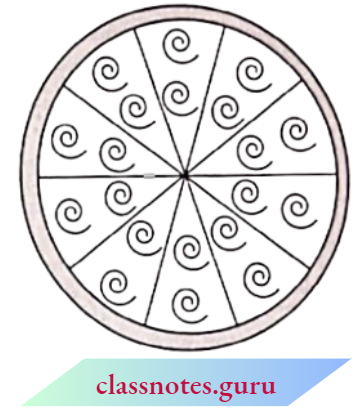
Solution:
Given
A brooch is made with silver wire in the form of a circle with a diameter of 35 mm. The wire is also used in making 5 diameters which divide the circle into 10 equal sectors as shown.
1. Diameter of circular brooch,
2r = 35 mm
= \(r=\frac{35}{2} \mathrm{~mm}\)
Length of required silver wire = 2πr
= \(2 \times \frac{22}{7} \times \frac{35}{2} \mathrm{~mm}=110 \mathrm{~mm}\)
Now, the length of 5 diameters = 5 x 2r
= \(5 \times 2 \times \frac{35}{2}=175 \mathrm{~mm}\)
Length of total wire = (110 + 175) mm
= 285 mm
The total length of the silver wire required = 285 mm
2. For each sector,
angle, \(\theta=\frac{360^{\circ}}{10^{\circ}}=36^{\circ}\)
∴ Area = \(\frac{\theta}{360^{\circ}} \times \pi r^2\)
= \(\frac{36^{\circ}}{360^{\circ}} \times \frac{22}{7} \times \frac{35}{2} \times \frac{35}{2}\)
= \(\frac{385}{4} \mathrm{~cm}^2\)
The area of each sector of the brooch = \(\frac{385}{4} \mathrm{~cm}^2\)
Question 10. An umbrella has 8 ribs which are equally spaced. Assuming an umbrella to be a flat circle of radius 45 cm, find the area between the two consecutive ribs of the umbrella.

Solution:
Given
An umbrella has 8 ribs which are equally spaced. Assuming an umbrella to be a flat circle of radius 45 cm
The radius of the umbrella,
r = length of ribs of umbrella = 45 cm
Here, number of sectors = 8
∴ Angle of sector = \(\theta=\frac{360^{\circ}}{8}=45^{\circ}\)
Now, the area between two ribs = area of the sector
= \(\frac{\theta}{360^{\circ}} \times \pi r^2\)
= \(\frac{45^{\circ}}{360^{\circ}} \times \frac{22}{7} \times 45 \times 45 \mathrm{~cm}^2\)
= \(\frac{22275}{28} \mathrm{~cm}^2\)
The area between the two consecutive ribs of the umbrella = \(\frac{22275}{28} \mathrm{~cm}^2\)
Question 11. A car has two wipers which do not overlap. Each wiper has a blade of length 25 cm sweeping through an angle of 115°. Find the total area cleaned at each sweep of the blades.
Solution:
Given, the length of the wiper blade
r = 25 cm = r(say)
The angle formed by this blade, θ =115°
∴ Area cleaned by a blade = area of sector formed by blade
= \(\frac{\theta \pi r^2}{360^{\circ}}=115^{\circ} \times \frac{22}{7 \times 360^{\circ}} \times(25)^2\)
= \(\frac{23 \times 22}{7 \times 72} \times 625=\frac{23 \times 11 \times 625}{7 \times 36}\)
= \(\frac{158125}{252} \mathrm{~cm}^2\)
∴ Total area cleaned by two blades
= 2 x area cleaned by a blade
= \(\frac{2 \times 158125}{252}=\frac{158125}{126} \mathrm{~cm}^2\)
The total area cleaned at each sweep of the blades =\(\frac{158125}{126} \mathrm{~cm}^2\)
Question 12. To warn ships of underwater rocks, a lighthouse spreads a red-coloured light over a sector of angle 80° to a distance of 16.51cm. Find the area of the sea over which the ships are warned. (Use π = 3.14)
Solution:
Given, the angle of the sector, θ = 80°
And distance or radius, r = 16.5 km
Area of sector
= \(\frac{\theta \pi r^2}{360^{\circ}}=\frac{80^{\circ} \times 3.14 \times(16.5)^2}{360^{\circ}}\)
= \(\frac{2 \times 3.14 \times 272.25}{9}=\frac{1709.73}{9}=189.97 \mathrm{~km}^2\) which is the area of the sea over which the ships are warned.
Question 13. A round table cover has six equal designs as shown. If the radius of the cover is 28 cm, find the cost of making the designs at the rate of ₹ 0.35 per cm2. (Use √3 = 1.7)
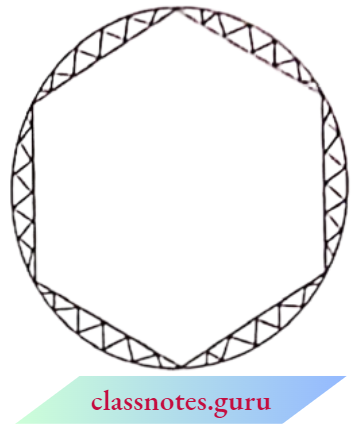
Solution:
Given
A round table cover has six equal designs as shown. If the radius of the cover is 28 cm
The radius of the table cover, r = 28 cm
Number of designs formed on table cover = 6
∴ The angle formed by each chord at the centre
= \(\frac{360^{\circ}}{6}=60^{\circ}\)
Now, the area of segment
= \(\frac{\pi r^2 \theta}{360^{\circ}}-\frac{1}{2} r^2 \sin \theta\)
= \(r^2\left(\frac{\pi}{360^{\circ}}-\frac{1}{2} \sin \theta\right)\)
⇒ Area of 6 segments
= \(6 r^2\left(\frac{\pi}{360^{\circ}}-\frac{1}{2} \sin \theta\right)\)
= \(6 \times 28 \times 28\left(\frac{60^{\circ}}{360^{\circ}} \times \frac{22}{7}-\frac{1}{2}-\sin 60^{\circ}\right)\)
= \(6 \times 28 \times 28\left(\frac{11}{21}-\frac{1}{2} \times \frac{\sqrt{3}}{2}\right)\)
= \(=6 \times 28 \times 28\left(\frac{11}{21}-\frac{1.73}{4}\right)=464.8 \mathrm{~cm}^2\)
Now, the total cost of making the design
= ₹ 0.35 x 464.8 = ₹ 162.68
The total cost of making the design = ₹ 162.68
Question 14. The area of a sector of angle p (in degrees) of a circle with radius R is
- \(\frac{p}{180} \times 2 \pi R\)
- \(\frac{p}{180} \times \pi R^2\)
- \(\frac{p}{360} \times 2 \pi R\)
- \(\frac{p}{720} \times 2 \pi R^2\)
Solution:
4. \(\frac{p}{720} \times 2 \pi R^2\)
Area of sector = \(\frac{\theta}{360^{\circ}} \times \pi r^2\)
= \(\frac{p}{360^{\circ}} \times \pi R^2=\frac{p}{720} \times 2 \pi R^2\)
NCERT Exemplar Solutions for Class 10 Maths Chapter 12 Area Related To Circles Exercise 12.3
Question 1. Find the area of the shaded region in the figure, if PQ= 24 cm, PR = 7 cm and O is the centre of the circle.
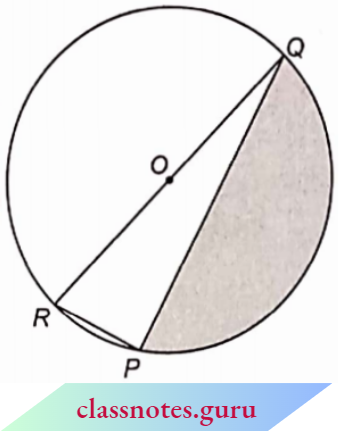
Solution:
Here, PQ = 24 cm and PR = 7 cm
∵ The angle in a semicircle is a right angle.
∴ ∠QPR = 90°
In ΔPQR,
QR2 = PQ2 + PR2 = 242 + 72 = 625
QR = 25 cm
If r is the radius of the circle, then
2r = 25 cm
= \(r=\frac{25}{2} \mathrm{~cm}\)
Area of shaded region = area of semicircle – area of ΔPQR
= \(\frac{1}{2} \pi r^2-\frac{1}{2} \times P Q \times P R\)
= \(\frac{1}{2} \times \frac{22}{7} \times \frac{25}{2} \times \frac{25}{2}-\frac{1}{2} \times 24 \times 7\)
= \(\frac{6875}{28}-84=\frac{4523}{28} \mathrm{~cm}^2\)
The area of the shaded region =\(\frac{4523}{28} \mathrm{~cm}^2\)
Question 2. Find the area of the shaded region, if the radii of the two concentric circles with centre O are 7 cm and 14 cm respectively and ∠AOC = 40°.

Solution:
Given
The radii of the two concentric circles with centre O are 7 cm and 14 cm respectively and ∠AOC = 40°.
Here, OA = 14 cm and OB = 7 cm
The angle of the sector, θ = 40°
∴ Area of the shaded portion
= \(\frac{\theta}{360^{\circ}} \times \pi \times\left(O B-O A^2\right)\)
= \(\frac{40^{\circ}}{360^{\circ}} \times \frac{22}{7} \times\left(14^2-7^2\right)\)
= \(\frac{1}{9} \times \frac{22}{7} \times 147=51.33 \mathrm{~cm}^2\)
The area of the shaded region =51.33 cm².
Question 3. Find the area of the shaded region, if ABCD is a square of side 14 cm and APD and BPC are semicircles.
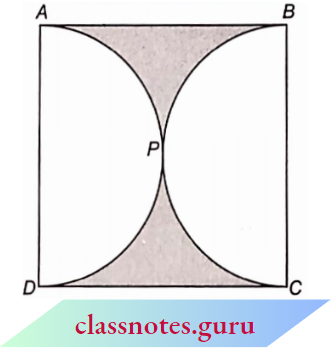
Solution:
Given
ABCD is a square of side 14 cm and APD and BPC are semicircles.
Side of square = 14
Area of square = 14 x 14 cm2 = 196 cm2
Diameter of each semicircle 2r = side of square = 14 cm
⇒ r = 7 cm
Area of one semicircle = \(\frac{1}{2} \pi r^2\)
Area of two semicircles = \(2 \times \frac{1}{2} \pi r^2=\pi r^2\)
= \(\frac{22}{7} \times 7 \times 7=154 \mathrm{~cm}^2\)
Area of shaded portion = area of the square – the sum of areas of two semicircles
= (196 – 154) cm2 = 42 cm2
The area of the shaded region = 42 cm2
Question 4. Find the area of the shaded region given, where a circular arc of radius 6 cm has been drawn with vertex O of an equilateral triangle OAB of side 12 cm as the centre.
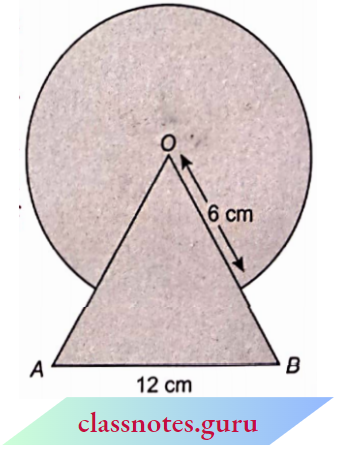
Solution:
Given
A circular arc of radius 6 cm has been drawn with vertex O of an equilateral triangle OAB of side 12 cm as the centre.
Each side of the equilateral triangle = 12 cm
and each angle = 60°
Now, the area of an equilateral triangle
= \(\frac{\sqrt{3}}{4} \times(\text { side })^2=\frac{\sqrt{3}}{4} \times 12 \times 12 \mathrm{~cm}^2\)
= 36√3 cm2
The radius of the circle, r = 6 cm
Angle of major sector, 0 = 360° – 60° = 300°
∴ Area of major sector
= \(\frac{\theta}{360^{\circ}} \times \pi r^2\)
= \(\frac{300^{\circ}}{360^{\circ}} \times \frac{22}{7} \times 6 \times 6=\frac{660}{7} \mathrm{~cm}^2\)
Now, the area of the shaded region = area of the equilateral triangle + area of a major sector.
= \(\left(36 \sqrt{3}+\frac{660}{7}\right) \mathrm{cm}^2\)
The area of the shaded region = \(\left(36 \sqrt{3}+\frac{660}{7}\right) \mathrm{cm}^2\)
Question 5. From each A corner of a square of side 4 cm a quadrant of a circle of radius 1 cm is cut and also a circle of diameter 2 cm is cut as shown. Find the area of the remaining portion of the square.

Solution:
Given
From each A corner of a square of side 4 cm a quadrant of a circle of radius 1 cm is cut and also a circle of diameter 2 cm is cut as shown.
Side of square = 4 cm
∴ Area of square = (side)2 = 42 = 16 cm2
The radius of a quadrant of a circle, r = 1 cm
∴ Area of four quadrants
= \(4 \times \frac{1}{4} \pi r^2\)
= \(\frac{22}{7} \times 1 \times 1=\frac{22}{7} \mathrm{~cm}^2\)
For the circle inside the square diameter, 2R = 2 cm ⇒ R = 1 cm
Area of this circle = \(\pi R^2=\frac{22}{7} \times 1 \times 1=\frac{22}{7} \mathrm{~cm}^2\)
Now, area of shaded portion = \(16-\left(\frac{22}{7}+\frac{22}{7}\right)=\frac{68}{7} \mathrm{~cm}^2\).
Question 6. In a circular table covered of radius 32 cm, a design is formed leaving an equilateral triangle ABC in the middle as shown. Find the area of the design.

Solution:
Given
In a circular table covered of radius 32 cm, a design is formed leaving an equilateral triangle ABC in the middle as shown.
ΔABC is an equilateral triangle.
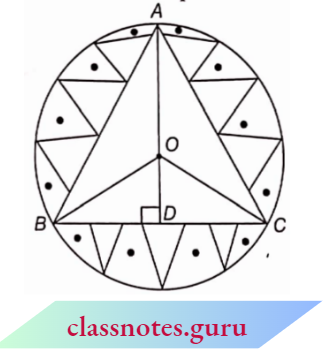
∴ ∠A = ∠B = ∠C = 60°
AD is perpendicular to BC.
∴ OA, OB, and OC are the radii of the circle.
Given that,
OA = OB = OC = 32 cm
∠BOC = 2
∠BAC = 2 x 60° = 120°
∴ \(\angle B O D=\frac{1}{2} \times 120^{\circ}=60^{\circ}\)
In ΔBOD
⇒ \(\sin 60^{\circ}=\frac{B D}{O B} ⇒ \frac{\sqrt{3}}{2}=\frac{B D}{32}\)
BD = 16√3 cm
BC = 2 BD = 32√3 cm
Area of ΔABC = \(\frac{\sqrt{3}}{4} \times B C^2\)
= \(\frac{\sqrt{3}}{4} \times(32 \sqrt{3})^2=768 \sqrt{3} \mathrm{~cm}^2\)
Area of circle = π(OB)2
= \(\frac{22}{7} \times 32 \times 32=\frac{22528}{7} \mathrm{~cm}^2\)
Now, the area of the shaded portion
= area of a circle – an area of ΔABC
= \(\left(\frac{22528}{7}-768 \sqrt{3}\right) \mathrm{cm}^2\).
The area of the shaded portion = \(\left(\frac{22528}{7}-768 \sqrt{3}\right) \mathrm{cm}^2\).
Important questions for Class 10 Maths Chapter 12 with solutions
Question 7. In the ABCD is a square of side 14 cm. With centres A. B. C and D, four circles are drawn such that each circle touch externally two of the remaining three circles. Find the area of the shaded region.

Solution:
Side of square ABCD = 14 cm
∴ Area of square = (14)2 =196 cm2
Radius of first quadrant \(r=\frac{14}{2}=7 \mathrm{~cm}\)
∴ The sum of area’s four quadrants
= \(4 \times \frac{1}{4} \pi r^2=\pi r^2\)
= \(\frac{22}{7} \times 7 \times 7=154 \mathrm{~cm}^2\)
Now, the area of the shaded portion = area of the square – the sum of areas of four quadrants
= 196 = 154 = 42 cm2
The area of the shaded region = 42 cm2
Question 8. depicts a racing track whose left and right ends are semicircular. The distance between the two inner parallel line segments is 60 m and they are each 106 m long. If the track is 10 m wide, find:
- The distance around the track along its inner edge.
- The area of the track.
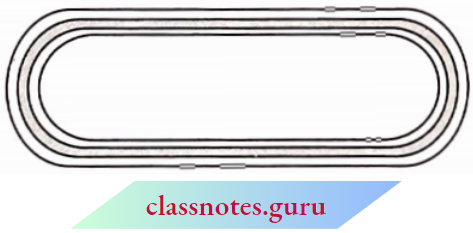
Solution:
Hence OB O’C = \(\frac{60}{2}=30 \mathrm{~m}\)
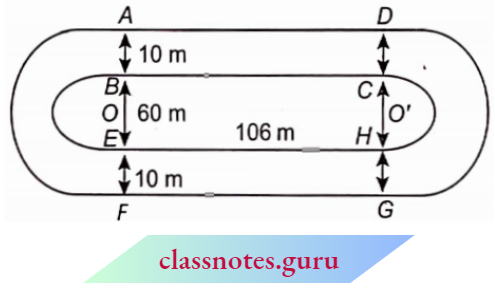
AB = CD = 10m
∴ OA = O’D = (30 + 10) m = 40 m
1. Distance covered in one round along the inner edges of the path.
= BC + EH + 2 x circumference of semicircle
= \(106+106+2 \times \frac{1}{2} \times 2 \pi \times 30\)
= \(212+2 \times \frac{22}{7} \times 30=\frac{2804}{7} \mathrm{~m}\)
2. Inner radius r = OB = 30 m
Outer radius R = OA = 40 m
Area of path = 2 x area of ABCD + 2 x area of semicircular rings
= \(=2 \times 106 \times 10+\frac{1}{2} \times \pi\left(R^2-r^2\right)\)
= \(2120+\frac{22}{7} \times\left(40^2-30^2\right)\)
= 2120 + 2200 = 4320 m2
Area of path is 4320 m2
Question 9. In the figure, AB and CD are two diameters of a circle (with centre O) perpendicular to each other and OD is the diameter of the smaller circle. If OA = 7 cm, find the area of the shaded region.
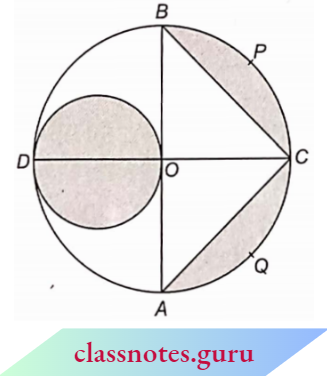
Solution:
Given
In the figure, AB and CD are two diameters of a circle (with centre O) perpendicular to each other and OD is the diameter of the smaller circle. If OA = 7 cm
The diameter of the smaller circle
OD = OA = 7 cm
∴ Radius r = \(\frac{7}{2}=3.5 \mathrm{~cm}\)
∴ Area of smaller circle = nr2
= \(\frac{22}{7} \times 3.5 \times 3.5 \mathrm{~cm}^2=38.5 \mathrm{~cm}^2\)
Area of semicircle OAQCPBO
= \(\frac{1}{2} \pi(O A)^2\)
= \(\frac{1}{2} \times \frac{22}{7} \times 7 \times 7=77 \mathrm{~cm}^2\)
Area of ΔABC = = \(\frac{1}{2} \times A B \times O C\)
= \(\frac{1}{2} \times 14 \times 7=49 \mathrm{~cm}^2\)
Now the area of the shaded portion = area of the smaller circle + area of OAQCPBO – an area of ABC
= 38.5 + 77 – 49 = 66. cm2
The area of the shaded region = 66. cm2
Question 10. The area of an equilateral triangle 11 ABC is 17320.5 cm2. With each vertex of the triangle as the centre, a circle is drawn with a radius equal to half the length of the side of the triangle. Find the area of the shaded region. (Use π= 3.24 and √3 = 1.73205).

Solution:
Given
The area of an equilateral triangle 11 ABC is 17320.5 cm2. With each vertex of the triangle as the centre, a circle is drawn with a radius equal to half the length of the side of the triangle.
Let the radius of each circle = r
Side of equilateral triangle = r + r = 2r
Now, area of equilateral triangle = \(\)
Given that, √3r2 = 17320.5 ⇒ 1.73205r2 = 17320.5
⇒ r2 = 10000 ⇒ r = 100 cm
Each angle of an equilateral triangle, θ = 60° Now, the area of sectors of three circles
= \(3 \times \frac{\theta}{360^{\circ}} \times \pi r^2\)
= \(3 \times \frac{60^8}{360^{\circ}} \times 3.14 \times(100)^2\)
= 15700 cm2
Area of shaded region = area of equilateral ABD = area of three sectors
= (17320.5 – 15700) cm2
= 1620.5 cm2
The area of the shaded region = 1620.5 cm2.
Question 11. On a square handkerchief, nine circular designs each of a radius of 7 cm are made. Find the area of the remaining portion of the handkerchief.
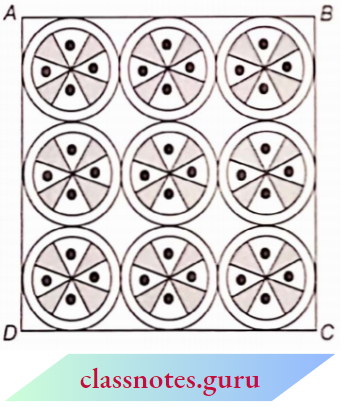
Solution:
Given, the radius of each circle, r = 7 cm
Diameter of circle, d = 14 cm = 42 cm (∵ diameter = 2 x radius)
Three horizontal circles touch each other.
Length of square = 3 x 14 cm = 42 cm
Now area of a circle = πr2 = (7)2
= \(\frac{22}{7} \times(7)^2=154 \mathrm{~cm}^2\)
∴ Area of 9 circles = 9 x 154 = 1386 cm2
Now, area of square ABCD = (side)2
= (42)2 = 1764 cm2
∴ Area of the remaining part of the handkerchief
= 1764 – 1386 = 378 cm2
The area of the remaining portion of the handkerchief = 378 cm2
Question 12. The OACB is a quadrant of a circle with centre O and a radius of 3.5 cm. If OD = 2 cm. find the area of the
- Quadrant OACB
- Shaded region.

Solution:
Given
The OACB is a quadrant of a circle with centre O and a radius of 3.5 cm. If OD = 2 cm
Radius of quadrant AOB. r= 3.5 cm
1. Area of quadrant OACB
= \(\frac{1}{4} \pi^2\)
= \(\frac{1}{4} \times \frac{22}{7} \times 3.5 \times 3.5=\frac{77}{8} \mathrm{~cm}^2\)
2. Area of ΔOBD
= \(\frac{1}{2} \times O B \times O D\)
= \(\frac{1}{2} \times 3.5 \times 2=3.5 \mathrm{~cm}^2=\frac{7}{2} \mathrm{~cm}^2\)
Area of the shaded portion
= area of quadrant OACB – area of OBD
= \(\left(\frac{77}{8}-\frac{7}{2}\right) \mathrm{cm}^2=\frac{49}{8} \mathrm{~cm}^2\)
Area of the shaded portion =\(\frac{49}{8} \mathrm{~cm}^2\)
Question 13. In the square O.ABC is inscribed in a quadrant OPBQ. If OA = 20 cm, find the area of the shaded region. (Use π = 3.14)

Solution:
Given
In the square O.ABC is inscribed in a quadrant OPBQ. If OA = 20 cm
Each side of square OABC = 20 cm
∴ Area of OABC = (20)2 = 400 cm2
Area of OABC = (20)2 = 400 cm2
In ΔOAB,
OB2 = OA2 ~ AB2 = 202 + 202 = 800
⇒ OB = 20√2cm
which is the radius of quadrant OPBQ.
Area of quadrant OPBQ
= \(\frac{1}{4} \pi(O B)^2=\frac{1}{4} \times 3.14 \times(20 \sqrt{2})^2\)
= 628 cm2
Now, the area of the shaded portion
= area of quadrant OPBD – area of square OABC
= (628 – 400) cm2 = 228 cm2
The area of the shaded region = 228 cm2
Question 14. AB and CD are respectively arcs of two concentric circles of radii 21 cm and 7 cm and centre O . If ∠AOB = 30°, find the area of the shaded region.
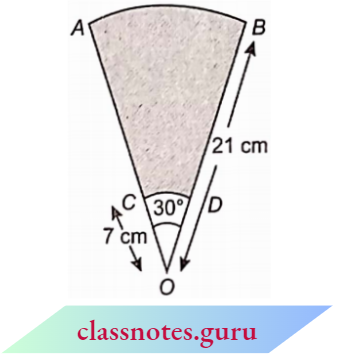
Solution:
Given
AB and CD are respectively arcs of two concentric circles of radii 21 cm and 7 cm and centre O . If ∠AOB = 30°
Here Q = 30°
Area of the shaded portion
= Area of sector OAB – area of sector OCD
= \(\frac{\theta}{360^{\circ}} \times \pi(O B)^2-\frac{\theta}{360^{\circ}} \times \pi(O C)^2\)
= \(\frac{\theta}{360^{\circ}} \times \pi\left[(O B)^2-(O C)^2\right]\)
= \(\frac{30^{\circ}}{360^{\circ}} \times \frac{22}{7} \times\left(21^2-7^2\right)\)
= \(\frac{1}{12} \times \frac{22}{7} \times 392 \mathrm{~cm}^2=\frac{308}{3} \mathrm{~cm}^2\)
Area of the shaded portion \(\frac{308}{3} \mathrm{~cm}^2\)
CBSE Class 10 Maths Area Related to Circles exemplar question answers
Question 15. The ABC is a quadrant of a circle of radius 14 cm and a semicircle is drawn with BC as diameter. Find the area of the shaded region.
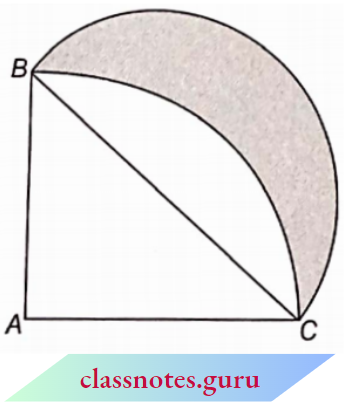
Solution:
Given
The ABC is a quadrant of a circle of radius 14 cm and a semicircle is drawn with BC as diameter.
For the quadrant ABC,
Radius r = 1 4 cm
∴ Area of quadrant ABC
= \(\frac{1}{4} \pi r^2\)
= \(\frac{1}{4} \times \frac{22}{7} \times 14 \times 14=154 \mathrm{~cm}^2\)
Area of \(\triangle A B C=\frac{1}{2} \times A B \times A C\)
= \(\frac{1}{2} \times 14 \times 14=98 \mathrm{~cm}^2\)
In right ABC,
BC2 = AC2 + AB2 = 142 + 142 = 392
BC = 14√2 cm
∴ For the semicircle formed on BC
Radius \(R=\frac{B C}{2}=\frac{14 \sqrt{2}}{2}=7 \sqrt{2} \mathrm{~cm}\)
and area of semicircle
= \(\frac{1}{2} \pi R^2\)
= \(\frac{1}{2} \times \frac{22}{7} \times(7 \sqrt{2})^2=154 \mathrm{~cm}^2\)
Now, the area of the shaded portion
= area of ΔABC + area of semicircle – area of quadrant ABC
= (98 + 154 – 154) cm2 = 98 cm2
The area of the shaded region = 98 cm2
Question 16. Calculate the area of the designed region in the figure common between the two quadrants of circles of radius 8 cm each.
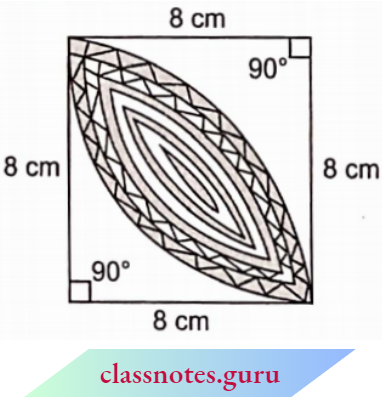
Solution:
The radius of each of quadrants ABMD and BNDC, r = 8 cm
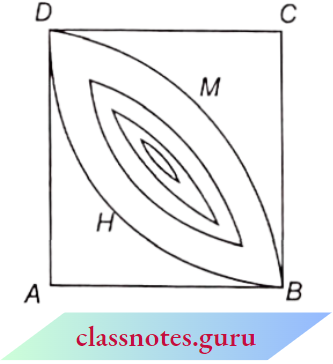
∴ Area of two quadrants
= \(2 \times \frac{1}{4} \pi r^2\)
= \(2 \times \frac{1}{4} \times \frac{22}{7} \times 8 \times 8\)
= \(\frac{704}{7} \mathrm{~cm}^2\)
and area of square ABCD = AB2 = 82 = 64 cm2
Now, the area of the shaded portion
= area of two quadrants – area of square ABCD
= \(\left(\frac{704}{7}-64\right) \mathrm{cm}^2\)
= \(\frac{256}{7} \mathrm{~cm}^2\)
The area of the designed region = \(\frac{256}{7} \mathrm{~cm}^2\)
NCERT Exemplar Solutions for Class 10 Maths Chapter 12 Area Related To Circles Multiple Choice Questions And Answers
Question 1. If the sum of the circumference of two circles of radii R1 and R2is equal to the circumference of a circle of radius R, then:
- R1 + R2 = R
- R1 + R2 > R
- R1 + R2 < R
- None of these
Answer: 1. R1 + R2 = R
Question 2. If the sum of the areas of two circles of radii and R1 and R2 is equal to the area of a circle of radius R, then:
- R1 + R2 = R
- R1 + R2 < R
- R12 + R22 = R2
- R12 + R22 < R2
Answer: 3. R12 + R22 = R2
Question 3. If the area of a circle is 154 cm2, then its circumference is:
- 11 cm
- 22 cm
- 44 cm
- 66 cm
Answer: 3. 44 cm
Question 4. The area of the largest triangle inscribed in a semicircle of radius r is:
- r2
- \(\frac{1}{2} r^2\)
- 2r2
- r2√2
Answer: 1. r2
Question 5. The area of the largest square inscribed in a circle of radius 8 cm is:
- 256 cm2
- 64 cm2
- 128 cm2
- 32 cm2
Answer: 3. 128 cm2
NCERT Class 10 Area of Circle and Sector problems
Question 6. The area largest circle inscribed in a square of side 4 cm is:
- 16π cm2
- 8π cm2
- 6π cm2
- 4π cm2
Answer: 2. 8ir cm2
Question 7. If the circumference of a circle and the perimeter of a square are equal, then the ratio of their areas is:
- 22:7
- 14:11
- 7:22
- 11:14
Answer: 2. 14:11
Question 8. In the adjoining figure, the perimeter of sector OAB is:
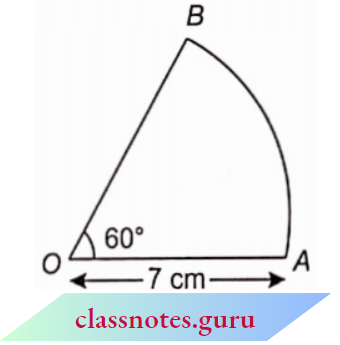
- \(\frac{64}{3} \mathrm{~cm}\)
- 26 cm
- \(\frac{64}{5} \mathrm{~cm}\)
- 19 cm
Answer: 1. \(\frac{64}{3} \mathrm{~cm}\)
Question 9. The length of the minute hand of a clock is 14 cm. The area swept by hand in one minute will be:
- 10.26 cm2
- 10.50 cm2
- 10.75 cm2
- 11.0 cm2
Answer: 1. 10.26 cm2
